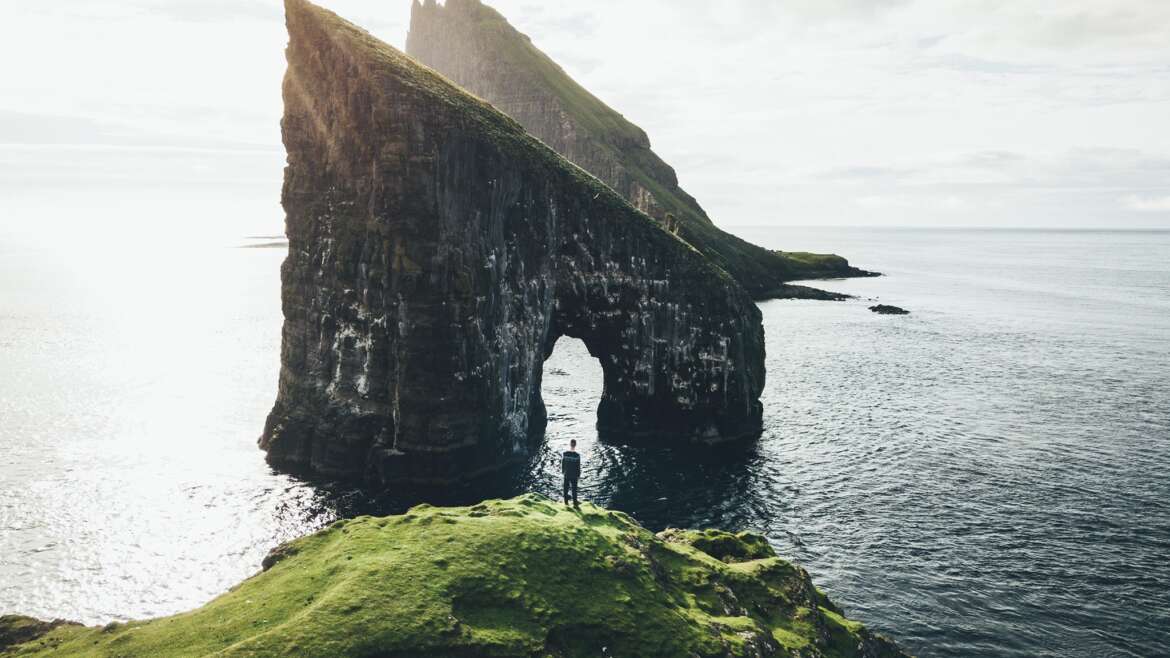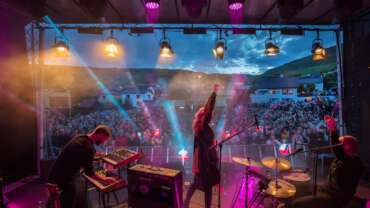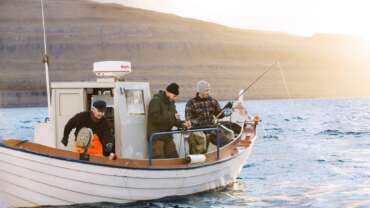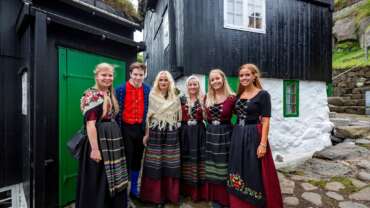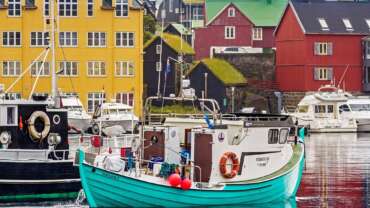Experiences in The Faroe Islands
HIKING IN THE FAROE ISLANDS
You’ll find that once you get off the beaten path on foot, the mountains and valleys will open up for you in marvellous and unexpected ways.
A short hike into the mountains affords numerous vantage points that overlook awe-inspiring peaks in one direction and the dishevelled surface of the ocean in another. One of the many special features of the Faroe Islands is that you don’t have to go far to experience magnificent and untouched nature. Look around you. Take a few steps. Take a deep breath and listen. It’s all right there!
SAFETY ISN’T EXPENSIVE, IT’S PRICELESS
We have hiked all over the Faroe Islands, seeking out the most beautiful trails and sightseeing spots. Each step you take on while hiking, we will have been there before you. Please be sure you are fully prepared by reading the hiking guide, which includes 23 hiking routes and important practical information.
BIRDWATCHING IN THE FAROE ISLANDS
Thousands and thousands of puffins flying over your head; black sea cliffs painted white by the sheer number of birds breeding there; the constant and powerful roar of thousands of kittiwakes calling at the same time; the power of a gannet as it dives and penetrates the water like a torpedo in the hunt for fish. These are all but a few of the things you can experience when watching the birds of the Faroe Islands.
The first thing that you might notice when coming to the Faroe Islands during the summer is the large number of breeding birds. Thousands of birds come to the Faroe Islands each summer to breed.
A total of 305 bird species have been recorded in the Faroe Islands as of January 1, 2012. Of these, around 50 species breed regularly on the islands and another 60 are regular visitors, while almost 200 of the recorded bird species are either scarce or rare visitors to the Faroe Islands.
Birdwatching is, of course, seasonal. Most visitors come to the Faroe Islands during summer, which is the breeding season for Faroese birds.
BICYCLING IN THE FAROE ISLANDS
More and more people are choosing to explore the Faroe Islands from the saddle on their bicycle. It’s no wonder why, considering the spectacular beauty one can see from the roads, mountains and valleys.
The infrastructure in the Faroe Islands is excellent, with all islands accessible either by sub-sea tunnels, bridges or ferries. This, combined with low volume traffic on most roads, makes bicycling in the Faroe Islands a pleasurable experience.
However, the weather can be unpredictable and change quickly, so it is important to keep some things in mind before setting off on your adventure.
KEEP IN MIND
Both in urban and rural areas, bike paths are uncommon. In most cases, cyclists will have to share the road with motor driven vehicles. Note also that there are many tunnels in the Faroe Islands, and in some cases these can be quite dark.
Dress for the occasion. You should wear good, protective clothing that is both warm and water resistant. It is a good idea to wear gloves, as temperatures can fluctuate suddenly.
Though the islands are far from flat, most gradients are gentle. Be prepared to bicycle on gravel roads in some places, as not all roads are paved.
In some cases the distance from one urban area to the next is quite considerable. It is important you make sure to bring appropriate equipment for basic repairs, as well as extra tubes and tires. Maps, GSP and communication equipment are also important.
Bicycles can easily cause damage to the terrain, so make sure to stay on path. Remember to always consider the environment. Also, it’s always a good idea to give someone your travel itinerary in case of an emergency.
ESSENTIAL BICYCLING EQUIPMENT
Your bike must have a bell, a white reflector visible from the front, yellow reflectors on the pedals and wheels and a red reflector at the back. Make sure yours is fitted with these before you bring the bike with you to the Faroe Islands. This is especially important because cyclists often encounter tunnels when cycling in the Faroe Islands.
When bicycling in the dark, you must have a working white light at the front and a red at the back. These can be bought at bike shops across the country.
Bike trailers must have two white reflectors on the front and two red on the back, with two yellow reflectors on each side. After dark, you must make sure your trailer has a red light either fitted at the back or the left-hand side.
TAKING CHILDREN ON YOUR BICYCLE
If you are over 15 years of age, you can transport two children under eight years old on your bicycle, providing you have the necessary cycle seats. If you have a bike trailer, you can take two children of any age. Children on bike seats and in trailers must always be fastened in.
FAROESE TRAFFIC REGULATIONS
You must always cycle on the right-hand side of the road and if there’s a bicycling path, you should use this. If you are turning left, cross over the road you will join, so that you are waiting with the traffic on the right-hand side. Then go with the traffic when the light is green. Bicyclists must use their arms to signal that they are slowing down, turning or stopping.
HELMETS
You are not legally required to wear a helmet. But it is a great idea to use one anyway!
DIVING – A MAGNIFICENT UNDERWATER WORLD
Diving as an activity is becoming more and more popular in the Faroe Islands. The beautiful, varied and unspoilt seabed found in the crystal clear water surrounding the 18 islands is simply very special. The excellent diving sites provide a great platform for exploring kelp forests and botanic seaweed gardens, fantastic drop-offs and grottos with exciting animal life.
The temperature of the water around the Faroes varies from four to 10 degrees Celsius, depending on the season. Visibility is best in the winter months, when the water temperature is low. This is also the best time for taking pictures while diving in the Faroe Islands. In the winter, visibility is about 30 metres and the average temperature 6 degrees. In the summer, plankton blooms sometimes degrade visibility, which can also limit opportunities for taking macro photos. Flash photography is not ideal during the summer as the particles flare up. However, visibility in general varies a great deal and even during the summer, it can reach 15-20 metres.
NEVER DIVE ALONE
It is of great importance that you never dive alone. Make sure you are always diveing with someone else. We recommend that a qualified divemaster or instructor with local knowledge supervises every dive as currents can be strong. There are diving courses for beginners available around the islands. Certified divers can hire equipment.
Make sure to bring a torch for every dive, so that you can explore cracks and look under rocks and fully appreciate the splendid colours and nuances of the flora and fauna. Who knows, you might even end up diving with seals!
SAILING IN THE FAROE ISLANDS
The 18 islands of the Faroe Islands are surrounding by the North Atlantic ocean. No point in the Faroe Islands is further than five kilometres from the ocean. Sailing is a fantastic way to experience the beautiful landscapes of the islands, offering completely different views compared to the ones from land.
You can discover these views of the Faroe Islands by sea while sailing with ships, boats or even an old schooner. Some of these ships or schooners are old and have a great history, making the journey even more interesting.
Some offer scheduled trips while others offer tailored trips according to your wishes.
Contact the various companies below for more information and to book.
SPEEDBOATING
Bumpimg across the ocean surrounding the Faroe Islands in a speedboat is an exhilarating experience. There are four companies that offer speedboating in the Faroe Islands. Check them out here.
RENT A TRADITIONAL FAROESE BOAT
Explore the fiords of the Faroe Islands with a traditional Faroese boat. Whether you enjoy fishing or just sailing along the seashore, this is a unique experience for a family or a group of friends.
The Faroese boat is the utmost creation of Faroese handicraft. The boatbuilding technique originated in the Viking culture, more than a thousand years ago.
The boats are suitable for 2-6 persons, and are fitted with a 6hp engine, have 4 oars and extensive safety equipment. You can also book guided fishing tours that include a meal using what you catch!
SURFING IN THE FAROE ISLANDS
Surfing as an activity in the Faroe Islands has developed a lot in recent years. There are great surfing opportunities in the Faroe Islands, but weather conditions on the islands means it is imperative that surfers become familiar with guidelines before heading out.
There is a surf spot for every swell direction, but they are different in regards to difficulty level and access.
We recommend that surfers in any case get in touch with Faroe Islands Surf Guide before testing their skills at sea, even if one is experienced. Going out with surfing guides is also highly recommend.
Faroe Islands Surf Guide offers surfing tours and lessons, and gear for rent.
OTHER ACTIVITIES
Interested in other adventure sports? We have you covered. A variety of companies in the Faroe Islands offer kayaking, cliff jumping, speedboating, abseiling and much more.
HORSE RIDING
THE FAROESE HORSE
The Faroese horse, called føroyska rossið in Faroese, has wandered in the rugged landscape of the windswept islands for over a thousand years. DNA analysis has shown that the Faroese breed is unique, not found anywhere else in the world.
But not long ago, the Faroese horse was nearly extinct. In 1960, there were only a handful of the beautiful, robust Faroese horses left – a drastic decline from the nearly 800 horses that roamed the islands a century and a half earlier. To prevent the extinction of the Faroes horse, people joined forces around this time and started breeding the one stallion and four mares that were left. Today, there are 74 Faroese horses, approximately 125 horses short of the number needed for the race to be considered safe.
HISTORY OF THE FAROESE HORSE
It is unclear where the Faroese horse originates. Some believe that they came with Irish monks in the 8th century, while others believe that settlers from Norway and the British Isles brought them along in the centuries that followed.
Between 1850 and 1920, many Faroese horses were sold to Britain. Because of their size and stamina, they were deemed ideal for pulling carts in the British coalmines. Many Faroese took the opportunity to make money and some sold all of their horses.
During this period, horses were imported from neighbouring Nordic countries because their horses were thought to be stronger. However, this proved to be a mistake as these horses were not as used to dealing with the Faroese weather as the Faroese horse was. Inevitably, the foreign horses bred with the Faroese horses, leaving many to believe that the pure Faroese breed was extinct. Fortunately, they were wrong.
CHARACTERISTICS OF THE FAROESE HORSE
The small, hardy and good-natured Faroese horses were originally used as workhorses throughout centuries. Today, they are mostly used for breeding and horseback riding. Because of their mild temperament, they are considered very suitable for children.
The colours of the harmonious and surefooted Faroese horse are normally brown, chestnut and black. The breed is known for its incredible endurance and ability to carry relatively large weight. The size of the horse varies, but normally ranges between 114 to 124 cm (45 to 49 inches). Because of its height, it should technically be called a pony, but because of its strength, the people of the Faroe Islands typically use horse instead. The Faroese horse can be compared to the Exmoor and Dartmoor ponies in Britain.
HORSES IN THE FAROE ISLANDS
The estimated number of horses of all breeds in the Faroes is around 400. The most popular breed in the Faroes is the Icelandic horse. The horse population also includes a small number of Norwegian fjordhester (fjord horses).



